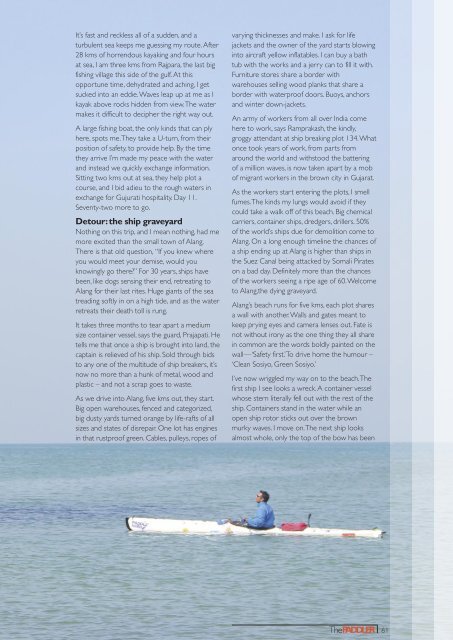The Paddler Autumn/Fall issue 2017
The International magazine for recreational paddlers. The best for all paddling watersports including whitewater kayaking, sea kayaking, expedition kayaking, canoeing, open canoeing and rafting. All magazines are in excess of 150 pages and absolutely free.
The International magazine for recreational paddlers. The best for all paddling watersports including whitewater kayaking, sea kayaking, expedition kayaking, canoeing, open canoeing and rafting. All magazines are in excess of 150 pages and absolutely free.
You also want an ePaper? Increase the reach of your titles
YUMPU automatically turns print PDFs into web optimized ePapers that Google loves.
It’s fast and reckless all of a sudden, and a<br />
turbulent sea keeps me guessing my route. After<br />
28 kms of horrendous kayaking and four hours<br />
at sea, I am three kms from Rajpara, the last big<br />
fishing village this side of the gulf. At this<br />
opportune time, dehydrated and aching, I get<br />
sucked into an eddie. Waves leap up at me as I<br />
kayak above rocks hidden from view. <strong>The</strong> water<br />
makes it difficult to decipher the right way out.<br />
A large fishing boat, the only kinds that can ply<br />
here, spots me. <strong>The</strong>y take a U-turn, from their<br />
position of safety, to provide help. By the time<br />
they arrive I’m made my peace with the water<br />
and instead we quickly exchange information.<br />
Sitting two kms out at sea, they help plot a<br />
course, and I bid adieu to the rough waters in<br />
exchange for Gujurati hospitality. Day 11.<br />
Seventy-two more to go.<br />
Detour: the ship graveyard<br />
Nothing on this trip, and I mean nothing, had me<br />
more excited than the small town of Alang.<br />
<strong>The</strong>re is that old question, “If you knew where<br />
you would meet your demise, would you<br />
knowingly go there?” For 30 years, ships have<br />
been, like dogs sensing their end, retreating to<br />
Alang for their last rites. Huge giants of the sea<br />
treading softly in on a high tide, and as the water<br />
retreats their death toll is rung.<br />
It takes three months to tear apart a medium<br />
size container vessel, says the guard, Prajapati. He<br />
tells me that once a ship is brought into land, the<br />
captain is relieved of his ship. Sold through bids<br />
to any one of the multitude of ship breakers, it’s<br />
now no more than a hunk of metal, wood and<br />
plastic – and not a scrap goes to waste.<br />
As we drive into Alang, five kms out, they start.<br />
Big open warehouses, fenced and categorized,<br />
big dusty yards turned orange by life-rafts of all<br />
sizes and states of disrepair. One lot has engines<br />
in that rustproof green. Cables, pulleys, ropes of<br />
varying thicknesses and make. I ask for life<br />
jackets and the owner of the yard starts blowing<br />
into aircraft yellow inflatables. I can buy a bath<br />
tub with the works and a jerry can to fill it with.<br />
Furniture stores share a border with<br />
warehouses selling wood planks that share a<br />
border with waterproof doors. Buoys, anchors<br />
and winter down-jackets.<br />
An army of workers from all over India come<br />
here to work, says Ramprakash, the kindly,<br />
groggy attendant at ship breaking plot 134. What<br />
once took years of work, from parts from<br />
around the world and withstood the battering<br />
of a million waves, is now taken apart by a mob<br />
of migrant workers in the brown city in Gujarat.<br />
As the workers start entering the plots, I smell<br />
fumes. <strong>The</strong> kinds my lungs would avoid if they<br />
could take a walk off of this beach. Big chemical<br />
carriers, container ships, dredgers, drillers. 50%<br />
of the world’s ships due for demolition come to<br />
Alang. On a long enough timeline the chances of<br />
a ship ending up at Alang is higher than ships in<br />
the Suez Canal being attacked by Somali Pirates<br />
on a bad day. Definitely more than the chances<br />
of the workers seeing a ripe age of 60. Welcome<br />
to Alang,the dying graveyard.<br />
Alang’s beach runs for five kms, each plot shares<br />
a wall with another. Walls and gates meant to<br />
keep prying eyes and camera lenses out. Fate is<br />
not without irony as the one thing they all share<br />
in common are the words boldly painted on the<br />
wall — ‘Safety first.’ To drive home the humour –<br />
‘Clean Sosiyo, Green Sosiyo.’<br />
I’ve now wriggled my way on to the beach. <strong>The</strong><br />
first ship I see looks a wreck. A container vessel<br />
whose stern literally fell out with the rest of the<br />
ship. Containers stand in the water while an<br />
open ship rotor sticks out over the brown<br />
murky waves. I move on. <strong>The</strong> next ship looks<br />
almost whole, only the top of the bow has been<br />
<strong>The</strong>PADDLER 61



